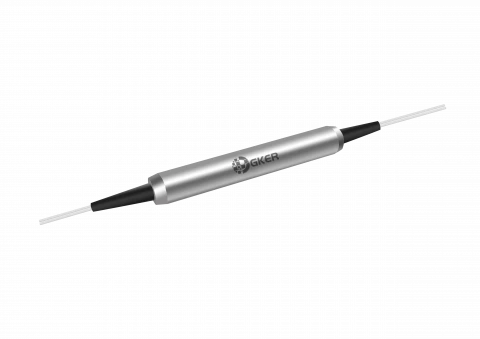Description
The 2 × 2 Dual Polarization Beam Combiner/Splitter from GKER Photonics is a high-performance optical component designed for combining or splitting two orthogonal polarization signals into one or two output fibers. This device excels in applications requiring precise signal management and high reliability, such as polarization mode dispersion compensators, Erbium-Doped Fiber Amplifiers (EDFAs), Raman Amplifiers, coherent telecommunication systems, and fiber sensors.
Featuring an exceptional combination of high extinction ratio and low insertion loss, the GK-DPBC/DPBS Series ensures optimal performance in demanding optical environments. The component operates efficiently at a center wavelength of 1550 nm, with a typical insertion loss of 0.6 dB for Grade P and 0.8 dB for Grade A, making it suitable for high-power and high-precision applications. The device supports up to 5 W of continuous wave optical power and can handle peak power up to 10 kW for nanosecond pulses.
The Polarization Beam Combiner/Splitter is engineered with advanced fiber technology, using PM1550 Panda Fiber for Ports 1 & 2, and either SMF-28 or PM1550 Panda Fiber for Ports 3 & 4. It provides a minimum extinction ratio of 20 dB for Grade P and 18 dB for Grade A, ensuring minimal signal degradation. Additionally, the device offers excellent directivity and return loss characteristics, with directivity reaching up to 50 dB and return loss up to 50 dB. Its robust design withstands a maximum tensile load of 5 N and operates within a temperature range from -5°C to +70°C, with storage capabilities extending from -40°C to +85°C.
The GK-DPBC/DPBS Series is available in various configurations to meet specific application needs, including different connector types, fiber jackets, and fiber lengths. This versatility makes it a valuable component in both standard and custom optical setups.
1310-1480-1550nm 2 × 2 Polarization Beam Combiner Splitter
Specifications
| Splitting Ratio: | Other |
|---|---|
| Central Wavelength: | 1550 nm |
| Power Handling: | Not Specified |
| Return Loss: | 50 dB |
| Grade: | Grade P Grade A - |
| Center Wavelength (λc): | 1550 nm |
| Operating Wavelength Range: | λc ±20 nm |
| Typ. Insertion Loss (Port 3 To Port 1 & 2, At Slow Axis, Port 4 To Port 1 & 2, At Fast Axis): | 0.6 0.8 dB |
| Max. Insertion Loss (Port 3 To Port 1 & 2at Slow Axis, Port 4 To Port 1 & 2, At Fast Axis): | 0.8 1.0 dB |
| Min. Extinction Ratio (for Splitter Only): | 20 18 dB |
| Min. Return Loss: | 50 dB |
| Max. Optical Power (Continuous Wave): | 5 W |
| Max. Peak Power For Ns Pulse: | 10 kW |
| Fiber Type: | PM1550Panda fiber for Port 1&2, SMF-28or PM1550Panda fiber for Port 3& 4 - |
| Max. Tensile Load: | 5 N |
| Operating Temperature: | -5 to+70 ℃ |
| Storage Temperature: | -40 to+85 ℃ |
Features
- Dual Polarization Management: Combines or splits two orthogonal polarization signals for enhanced signal control
- High Extinction Ratio: Maintains a minimum extinction ratio of 18 dB (Grade A) and 20 dB (Grade P) for optimal performance
- Low Insertion Loss: Ensures minimal signal loss with typical values as low as 0.6 dB (Grade P) and 0.8 dB (Grade A)
- High Power Handling: Capable of handling up to 5 W of continuous wave optical power, with peak power handling up to 10 kW for ns pulses
- Versatile Fiber Compatibility: Available with PM1550 Panda Fiber for Ports 1 & 2 and SMF-28 or PM1550 Panda Fiber for Ports 3 & 4
Applications
- EDFA: Efficiently combine pump lasers in Erbium-Doped Fiber Amplifiers to enhance amplification
- Raman Amplifier: Improves the efficiency of Raman Amplifiers by combining multiple pump lasers
- Coherent Telecommunication Systems: Ensures stable and high-quality signal transmission in coherent optical communication systems
- Polarization Mode Dispersion Compensator: Used to correct polarization mode dispersion in advanced optical networks
- Fiber Sensors: Integrates with fiber sensors to improve sensitivity and signal accuracy
Frequently Asked Questions
What is the function of the Dual Polarization Beam Combiner/Splitter?
What are the typical applications for this device?
What is the typical insertion loss for this device?
What is the maximum optical power handling capacity?
What fiber types are compatible with this device?
What is the extinction ratio of this device?
What are the operating and storage temperature ranges?
Can this device be used for polarization mode dispersion compensation?
What is the directivity of the device?
Similar Products
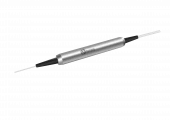
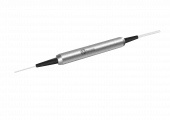
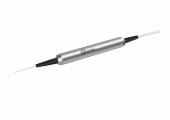
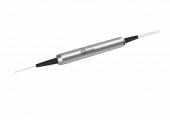
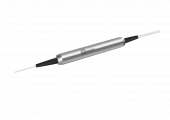
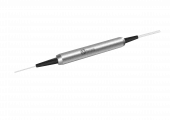
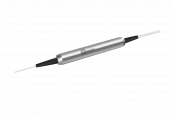
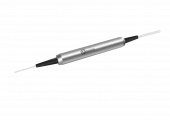




Your inquiry has been received.
Create an account by adding a password
Why create an account?
- Auto-complete inquiry forms
- View and manage all your past messages
- Save products to your favorites
- Close your account anytime — no hassle
